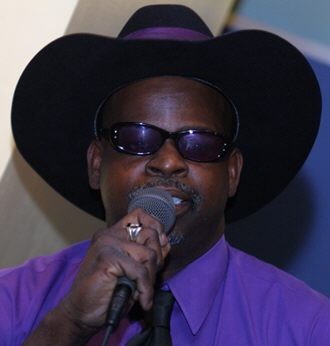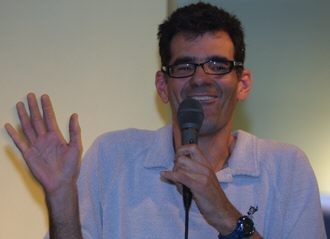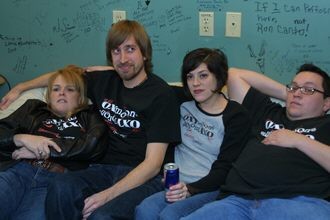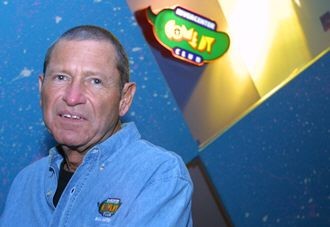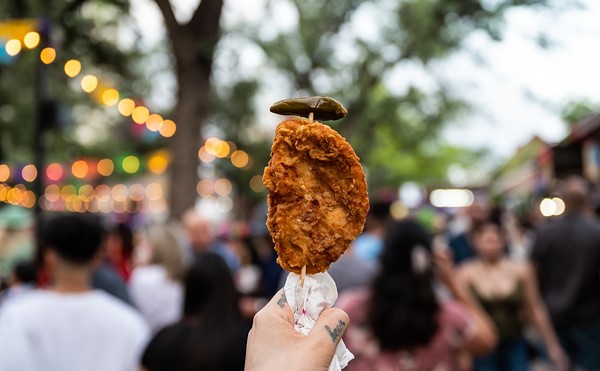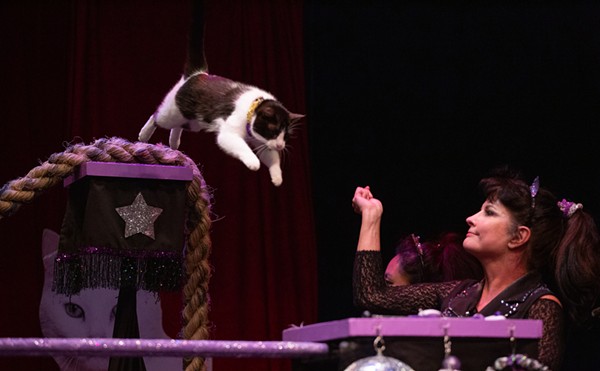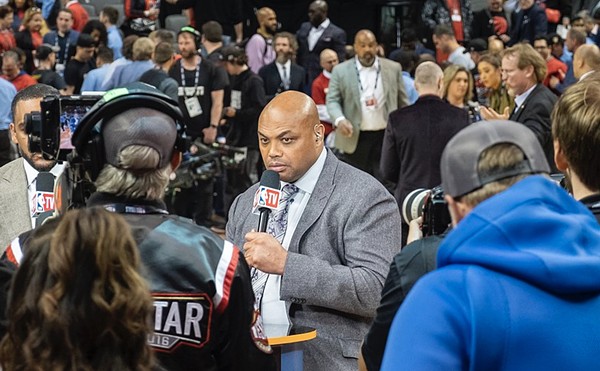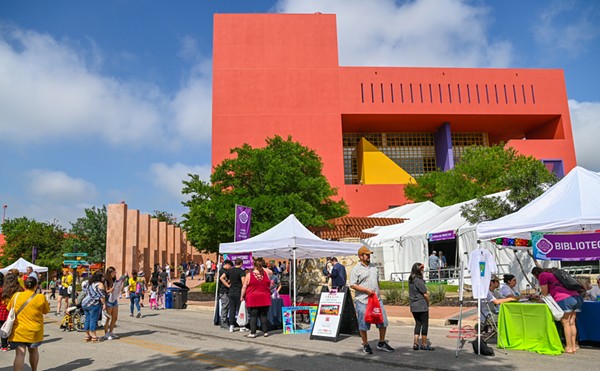|
Top: G.Q. Country, aka Willie Caldwell. Middle: comedian Mike Dunlop. Bottom: Oxymorons Hilary Keahey, Chuck Robinson and Chuy Zarate with Reverend Rocco (center). Photos by Antonia Padilla. |
More than 103,000 San Antonians are employed by health-care companies to help us fight sickness. Our three military bases, staffed by more than 73,000, may help keep us safe from a land invasion. But who’s going to fight for our right, our need, to laugh?
To get a first-hand look at the frontlines of comedy, the San Antonio Current spent the better part of January investigating the next generation of South-Texas comedians. The open-mic show at the Rivercenter Comedy Club on Friday and Saturday afternoons seemed a good place to start.
At first, the future looked bleak. “I’m so broke, a homeless guy offered me money,” says one of the newer guys. He studies his notes, and tries again. His girlfriend, he says, couldn’t afford braces, so she had to write “Security” on her teeth “to keep them in line.” It gets a soft chuckle.
More standup hopefuls step up for their seven-minute routines, and the comic momentum lurches like a car being driven by someone who’s still negotiating the relationship between stick shift and clutch.
“Anybody here from out of town?” begins one guy, even though someone else already asked the same question on this tourist-scarce day, and came up empty. Ouch. Another guy starts talking about Halloween costumes (did I mention it’s January?). He likes the idea of dressing like a banana. Very apeeling.
To be fair, even comic legends like Dave Chappelle get booed off stage early in their careers.
“It’s like any other art form,” says Dave May, a 23-year comedy veteran, founder of the long-running Oxymorons improv troupe, and teacher to anyone willing to shell out $500 for a seven-week, six-session crash course in standup. “It has to be learned. Even Picasso had to learn to paint, by starting with bowls of fruit.”
Of course, not every artist is as inventive and prolific as Picasso. And if it’s a good thing that comics like Chappelle soldiered through their early failures, there’s no guarantee that an aspiring comedian won’t spend years honing their craft —and still suck.
Nonetheless, after hanging out at several open-mic events, you can see a definite correlation between standup experience and better jokes, delivery, and timing.
“Garage sales are stupid,” says Todd Larson, who has been performing since 2002. “You find things for sale like an opened half box of tampons. And then there’s the negotiating. ‘How much for the toilet brush?’ ‘Well, I don’t know,’” he says. “’It’s a pretty gooood toilet brush … Let’s say, ah … 75 cents.’” A pause. “‘Can you throw in the half box of tampons?’”
Freudian therapists could have a field day with some of the routines. “My mom sold sex toys for a living,” says Mark Riojas of his father-deprived childhood, “so you can imagine the pacifiers I had growing up.”
Other routines get you smiling, and thinking. “Seventy percent of the people who contract herpes get it from someone with no visible symptoms,” says Davis RS. How desperate for sex, he muses, are people in the remaining 30 percent?
Mike Dunlop complains about his love life, especially the “plastic-shower-curtain smell” of his inflatable girlfriends. Then he wonders, “If you spend time with a hooker, and she turns out to be a guy, is that cheating?”
A few have material that’s topical. Brandon White talks about President Bush’s recent State of the Union speech, and the buzz beforehand: that the President was going to — finally — apologize. “So what do we hear? He says, ‘I’m sorry, America. I should have sent more troops.’”
Others try out jokes with a local connection. “People come from other countries to see the Alamo, so when they see a gang fight, they think it’s a re-enactment,” Doug Jones says. “Go, Davy Crockett!” he says, like an eager Asian tourist taking an imaginary picture.
Jones, who looks about as Latino as his Anglo name sounds, says he has to be careful when he’s visiting his Mexican mom, because he looks so much like his dad she usually calls the police to report a restraining-order violation.
The open-mic sessions give hopefuls more than just a chance to sandwich new material between reliable icebreakers and closing gags. They can also heckle each other.
Fernando Martinez is onstage talking about receding hairlines. “How about your receding career?” Jones shouts. Martinez’s smile is full of menace, and he flashes his middle finger like a switchblade. “Andrew Dice Clay wants his act back,” Jones says, as he steps up to take his turn at the mic.
“Comics mess with each other, nonstop,” says Ben Huerta, who has been running the Rivercenter Comedy Club shows since the space on the top floor of the old Joske’s Department Store became available in June 1993.
Those who choose the pot-holed and poverty-stricken road to comedic success tend to form lasting bonds, however. Established headliners Kelly Bob and Edmond Aguirre first met when they were learning comedy at the Comedy Gym under the tutelage of veteran instructor Sam Cox. They were back in San Antonio last month to team up with May, Charles Brockman, and Irene Peña for a charity performance to help out Louie Montalvo, another long-time San Antonio comic who is recovering from a heart attack and quintuple-bypass surgery.
Louie was still too sick to attend the benefit, staged at the Afterburner near Lackland Air Force Base on January 20. But the comedians donated their time, the Afterburner staff worked for free, and the event raised more than $1,500 for Montalvo, who is uninsured.
Not everyone at today’s open mic is ready to quit their day jobs, however. A few see comedy as a hobby, not a career.
“I just like getting up there,” says truck driver Willie Caldwell, aka G.Q. Country, who participates in “four or five” open-mic events a year. He first got hooked in 2004 after cracking up co-workers at an event held by his company. “I was telling them how all these drivers were passing me, letting me know they thought the company was number one,” Caldwell recalls. There was only one problem. “They’re not using the right finger.” (Caldwell asked that we not publish the name of his company, so we’ll just say it’s a media-shy conglomerate that raked in, um, $312 billion in sales last year.)
But most of San Antonio’s comedy hopefuls would like to progress from open mic to emcee to feature comic to headliner. According to Huerta, even comfortably-paid headliners, however, need to book 25 to 30 weekly gigs a year to make comedy a full-time job.
“The features have the worst end of the deal, financially,” he says. “They make maybe three times what the opening act gets, but they have to spend their money on travel,” although comedy clubs will often provide lodging to help out.
The last step up the pyramid — from comedy-club headliner to household-name celebrity — is least certain of all. “The irony is that a lot of the lesser-known comic headliners are just as funny and polished as any folks on TV or in the movies, but they haven’t been discovered yet,” Huerta says.
Those still struggling at the open-mic shows have found day jobs that give them the flexibility they need to perform: substitute teaching, gigs at SeaWorld, odd jobs for relatives who run small businesses, or standup for people enrolled in defensive driving or TABC liquor-license courses.
“I’m not the best person to ask about how to get standup jobs,” admits Mike Dunlop, who first dabbled in comedy in 1994 at a club called Coconuts in Pensacola, Florida. He also lived for a while in Philadelphia, doing radio show stunts like covering himself in K-Y Jelly and careening down a waterpark slide in the dead of winter.
To book Rivercenter Comedy Club’s headliners, Huerta relies on Coastal Entertainment Productions in Astoria, New York. They deliver nationally known up-and-comers like Jo Koy, who recently scored a standing ovation on NBC’s The Tonight Show with Jay Leno, and performed at the club in January. But Huerta’s operations managers also keep close tabs on local performers, and the club can sometimes offer them opportunities beyond the open-mic sessions. In late March, Rivercenter will host two major amateur events: the finale for top bragging rights as the “Funniest Comedian in South Texas” on Monday, March 26, followed up by the San Antonio tryout for NBC’s fifth annual Last Comic Standing competition on March 30.
Apart from those long shots, however, the best way for someone from San Antonio to hit the big time is to perfect their craft locally, hone their five-to-seven-minute open-mic routines, keep adding fresh material until they have least 20 to 30 minutes of really good stuff, then spend some time in L.A. or New York. And hope to get very, very lucky.
Rick Gutierrez is one local comic who followed that path. The San Antonio native started as a local comic, worked his way up to traveling headliner, moved to L.A., and has appeared in some commercials, Huerta says. His best chance at a big break so far is coming March 16 with the release of Tortilla Heaven, which also features veteran Latino comic George Lopez.
San Antono is a thoroughly multicultural town, and many of the comics here are bilingual. Oddly, however, almost all of the standup performances are in English. “Even comics fluent in Spanish only do shows in English,” Huerta says.
That could change, but for now the standup art form still seems to be more closely connected to 1920s vaudeville on New York’s Lower East Side than to 21st-century multicultural Texas.
“Spanish comedy is a whole different genre,” Huerta says. “It’s more Sábado Gigante. More slapstick.” He thinks for a moment. “The Benny Hill Show could probably be translated to Spanish very easily.”
Even within the standup genre, there are different comic styles. “It can be an art form, when it’s done right,” says James Ponce. “I have no problem with fart jokes, those are always going to be funny,” but to him, those laughs are low-hanging fruit.
Ponce’s goal is to achieve the understated artistry of comedians like Chris Rock, Dave Chappelle, and Bob Newhart, who aren’t content with standup comedy as mere entertainment, and try, instead, for something more.
Mark Riojas is working the open mics and warming up audiences at other venues in town, such as the Enchilada Warehouse, for such local headliners as Ruby Collins and Jay LaFarr. He also likes a comic style that keeps things real, without too much distortion or comic exaggeration.
“The majority of my jokes are from things that I’ve experienced,” he says. (Yes, his mom really did make her living selling risqué novelties.) He got his start, and still performs, with Comedia A Go-Go, a group of five Latinos who combine live sketch comedy interspersed with prerecorded videos.
Some top stars, like Andrew Dice Clay, say they’ve created a stage persona that has little resemblance to who they really are. They’re the exception, Huerta says. “Most of the time, it’s about who they are, and the things that happen to them,” he says. “They have to be very brave. ‘This is me, I’m putting it all out there for you. Please like it.’”
There may be plenty of careers that are safer for the psyche and the wallet, but few that offer the addictive rush of knowing you’ve created what Huerta refers to simply as “The Ride” — written, directed, and performed by the standup comedian him- or herself.
“I’ve never done standup,” he says. “But without a doubt, they can feel when they have an audience. Everybody in the room feels it,” Huerta continues. “People are connected. And it’s like a movie, when you lose that awareness that the actor is an actor. You get them laughing, and you’ve got them.
| Photo by Antonia Padilla. |
“The audience is just being entertained,” Huerta adds. “They don’t see it the way the entertainer sees it. If you’re the one who’s watching, it’s just a little ride. Then it’s over, and the ride has ended. But to be the person who’s conducting the ride … wow. That’s something else.”

